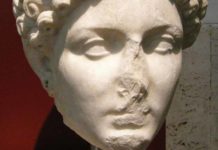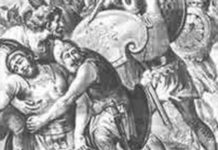Leptis Magna, a city on the coast of Libya, was a prominent city in Africa in the days of the Roman Empire.
Leptis Magna, located in the present-day African country of Libya, was an important port in the heyday of the Roman Empire. It was a beautiful city which mixed Roman and Arab architecture. Its ruins are still being explored by archaeologists today, and many new discoveries are being made.
From Phoenicia to Rome
The city was first settled by the Phoenicians, a sea-faring people from Lebanon, in 1100 B.C. Carthage had ownership of the city until 146 B.C. After the Punic Wars, the Romans acquired and settled the area, adding it to their republic around 23 B.C. When the emperor Tiberius came to power, the city was officially brought into the Roman Empire and became a major trading center.
Prosperity Under a New Emperor
The city reached its peak when Septimius Severus, a native of Leptis Magna, became the Roman emperor. He favored his hometown more than any other provincial city and started many construction projects, building many of the structures whose ruins remain today. Under his rule, Leptis Magna eventually became the third most important city in Roman-controlled Africa.
Leptis’ Decline and Abandonment
Leptis Magna prospered until the Crisis of the Third Century A.D., a massive decline in trade caused by civil unrest and repeated invasions of so-called barbarians into the Roman Empire. Order was eventually restored, but not until irrevocable damage to Leptis Magna’s well-being had been done. The situation was made even worse by a corrupt Roman governor named Romanus, who demanded a “tribute” in return for protection from attacks from the Vandal barbarians. The citizens were unable to pay, and so the Vandals invaded and took control of the city in 439 A.D. In 523 A.D. the Berbers, an indigenous people who lived in North Africa, sacked Leptis Magna. The city never truly recovered from the attack, and by the 650s it was deserted.
Ruins of Leptis Magna
Leptis Magna contains some of the most well-preserved Roman buildings known to archaeologists. The theatre, for example, is nearly intact, and is situated so that the audience faces the sea. Another building, called a macellum, or indoor market, is also mostly intact, as is the octagonal platform that surrounds it. But the most unique feature by far is the Hunting Baths, a complex of concrete domes that housed the Roman-style baths. To many visitors, they are similar to many Arab-style buildings.
This Roman city holds a special importance in history, both for its prominence and for its remarkable ruins. It gives archaeologists and tourists alike a special look into Roman-held Africa.
Sources:
- Lost Cities of the Ancient World, M.T. Guaitoli and S. Rambaldi, Barnes and Noble Publishing (2002)








